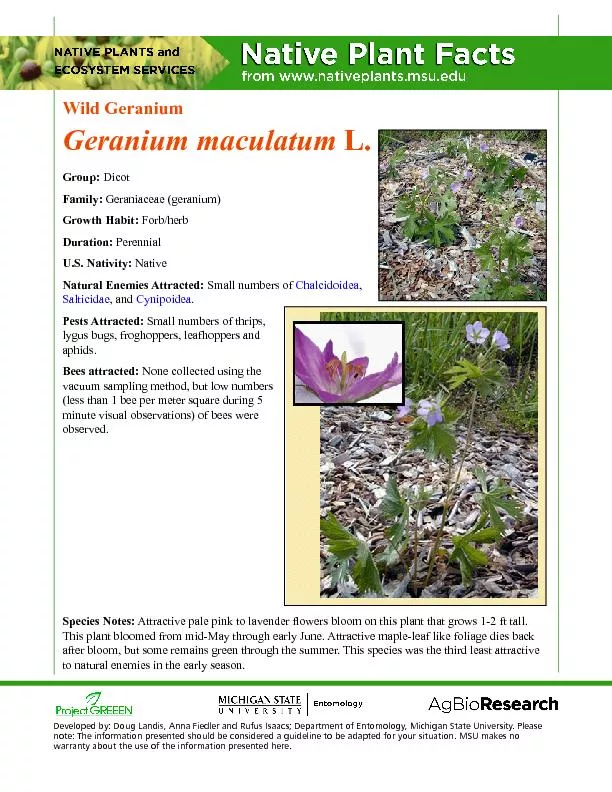/


note The information presented should be considered a guideline to be adapted for your situation MSU makes no warranty about the use of the information presented here Wild Geranium Geranium macul ID: 284075
Download Pdf The PPT/PDF document "Developed by: Doug Landis, Anna Fiedler ..." is the property of its rightful owner. Permission is granted to download and print the materials on this web site for personal, non-commercial use only, and to display it on your personal computer provided you do not modify the materials and that you retain all copyright notices contained in the materials. By downloading content from our website, you accept the terms of this agreement.
Developed by: Doug Landis, Anna Fiedler and Rufus Isaacs; Department of Entomology, Michigan State University. Please note: The information presented should be considered a guideline to be adapted for your situation. MSU makes no warranty about the use of the information presented here. Wild Geranium Geranium maculatum L. Group: Dicot Family: Geraniaceae (geranium) Growth Habit: Forb/herb Duration: Perennial U.S. Nativity: Native Natural Enemies Attracted: Small numbers of Chalcidoidea, Salticidae, and Cynipoidea. Pests Attracted: Small numbers of thrips, lygus bugs, froghoppers, leafhoppers and aphids. Bees attracted: None collected using the vacuum sampling method, but low numbers (less than 1 bee per meter square during 5 minute visual observations) of bees were observed. Species Notes: Attractive pale pink to lavender �owers bloom on this plant that grows 1-2 ft tall. This plant bloomed from mid-May through early June. Attractive maple-leaf like foliage dies back after bloom, but some remains green through the summer. This species was the third least attractive to natural enemies in the early season. MSU is an affirmative-action, equal-opportunity employer. Michigan State University Extension programs and materials are open to all without regard to race, color, national origin, gender, gender identity, religion, age, height, weight, disability, political beliefs, sexual orientation, marital status, family status or veteran status. Issued in furtherance of MSU Extension work, acts of May 8 and June 30, 1914, in cooperation with the U.S. Department of Agriculture. Thomas G. Coon, Director, MSU Extension, East Lansing,MI 48824. This information is for educational purposes only. Reference to commercial products or trade names does not imply endorsement by MSU Extension or bias against those not mentioned. About the Plant Species Graph: Average number of bene�cial insects collected at each plant species the week before, during, and after peak bloom, for plant species blooming October (+ standard error). Wild geranium ( Geranium maculatum ) boxed in red. Bars for natural enemies are in green, bars for bees are in yellow. Bars for native plants are solid and nonnative plants are striped. The black line on the top graph shows the number of natural enemies in control). Plants are listed in order of peak bloom. Habitat: Horticultural tolerance includes full sun to partial dry). Naturally occurring in rich deciduous woods, including moist sites such as pond borders, streamsides, and swamp forests. Usually grows in rich deciduous forests. Cultivation and Management: Flowers from seed in second or third year. Also can be grown from plug material (�owers in �rst or second year). This plant is showy and long-lived. Availability: Species is available as seed, plug or container grown material from various native plant nurseries. See the Michigan Native Plant Producers Association For more information: View the online USDA-NRCS PLANTS database Plant Species Graph MSU is an affirmative-action, equal-opportunity employer. Michigan State University Extension programs and materials are open to all without regard to race, color, national origin, gender, gender identity, religion, age, height, weight, disability, political beliefs, sexual orientation, marital status, family status or veteran status. Issued in furtherance of MSU Extension work, acts of May 8 and June 30, 1914, in cooperation with the U.S. Department of Agriculture. Thomas G. Coon, Director, MSU Extension, East Lansing,MI 48824. This information is for educational purposes only. Reference to commercial products or trade names does not imply endorsement by MSU Extension or bias against those not mentioned. About the Plant Species Graph: Average number of bene�cial insects October (+ standard error). Wild yellow. Bars for native plants are solid and nonnative plants are striped. The or third year. Also can be grown from plug material (�owers in �rst or second year). This plant is showy and long-lived. Availability:Michigan Native Plant Producers Association For more information: View the online USDA-NRCS Developed by: Doug Landis, Anna Fiedler and Rufus Isaacs; Department of Entomology, Michigan State University. Please note: The information presented should be considered a guideline to be adapted for your situation. MSU makes no warranty about the use of the information presented here. Wild GeraniumGroup: Growth Habit:Natural Enemies Attracted: Pests Attracted: Attractive pale pink to lavender �owers bloom on this plant that grows 1-2 ft tall. This plant bloomed from mid-May through early June. Attractive maple-leaf like foliage dies back after bloom, but some remains green through the summer. This species was the third least attractive